fuel type Alfa Romeo Giulietta 2017 Owner's Manual
[x] Cancel search | Manufacturer: ALFA ROMEO, Model Year: 2017, Model line: Giulietta, Model: Alfa Romeo Giulietta 2017Pages: 212, PDF Size: 4.56 MB
Page 33 of 212
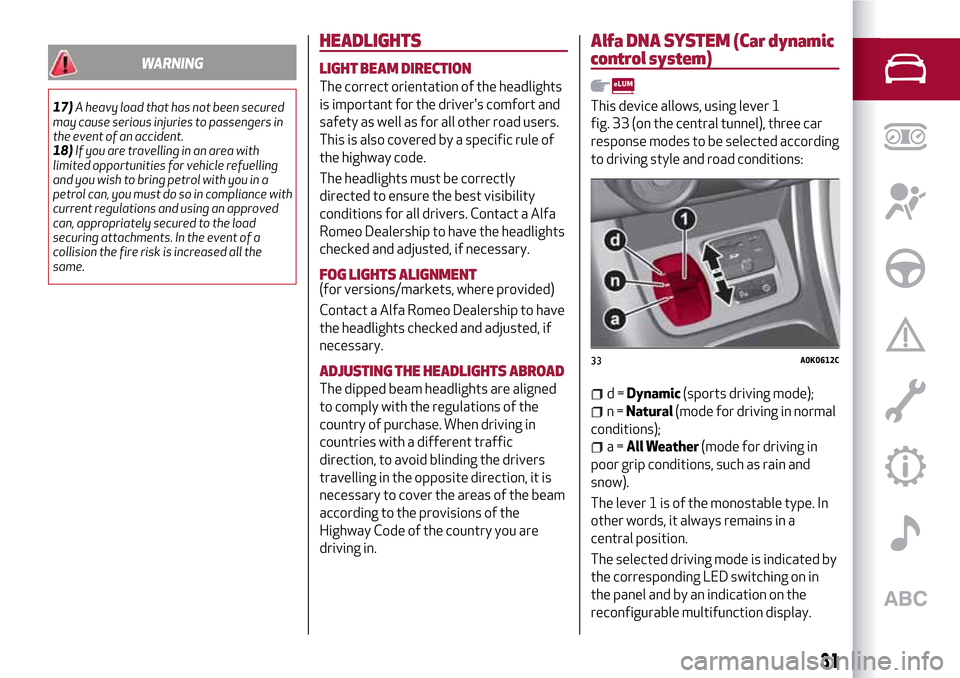
WARNING
17)A heavy load that has not been secured
may cause serious injuries to passengers in
the event of an accident.
18)If you are travelling in an area with
limited opportunities for vehicle refuelling
and you wish to bring petrol with you in a
petrol can, you must do so in compliance with
current regulations and using an approved
can, appropriately secured to the load
securing attachments. In the event of a
collision the fire risk is increased all the
same.
HEADLIGHTS
LIGHT BEAM DIRECTION
The correct orientation of the headlights
is important for the driver's comfort and
safety as well as for all other road users.
This is also covered by a specific rule of
the highway code.
The headlights must be correctly
directed to ensure the best visibility
conditions for all drivers. Contact a Alfa
Romeo Dealership to have the headlights
checked and adjusted, if necessary.
FOG LIGHTS ALIGNMENT(for versions/markets, where provided)
Contact a Alfa Romeo Dealership to have
the headlights checked and adjusted, if
necessary.
ADJUSTING THE HEADLIGHTS ABROAD
The dipped beam headlights are aligned
to comply with the regulations of the
country of purchase. When driving in
countries with a different traffic
direction, to avoid blinding the drivers
travelling in the opposite direction, it is
necessary to cover the areas of the beam
according to the provisions of the
Highway Code of the country you are
driving in.
Alfa DNASYSTEM (Car dynamic
control system)
This device allows, using lever 1
fig. 33 (on the central tunnel), three car
response modes to be selected according
to driving style and road conditions:
d=Dynamic(sports driving mode);
n=Natural(mode for driving in normal
conditions);
a=All Weather(mode for driving in
poor grip conditions, such as rain and
snow).
The lever 1 is of the monostable type. In
other words, it always remains in a
central position.
The selected driving mode is indicated by
the corresponding LED switching on in
the panel and by an indication on the
reconfigurable multifunction display.
33A0K0612C
31
Page 35 of 212
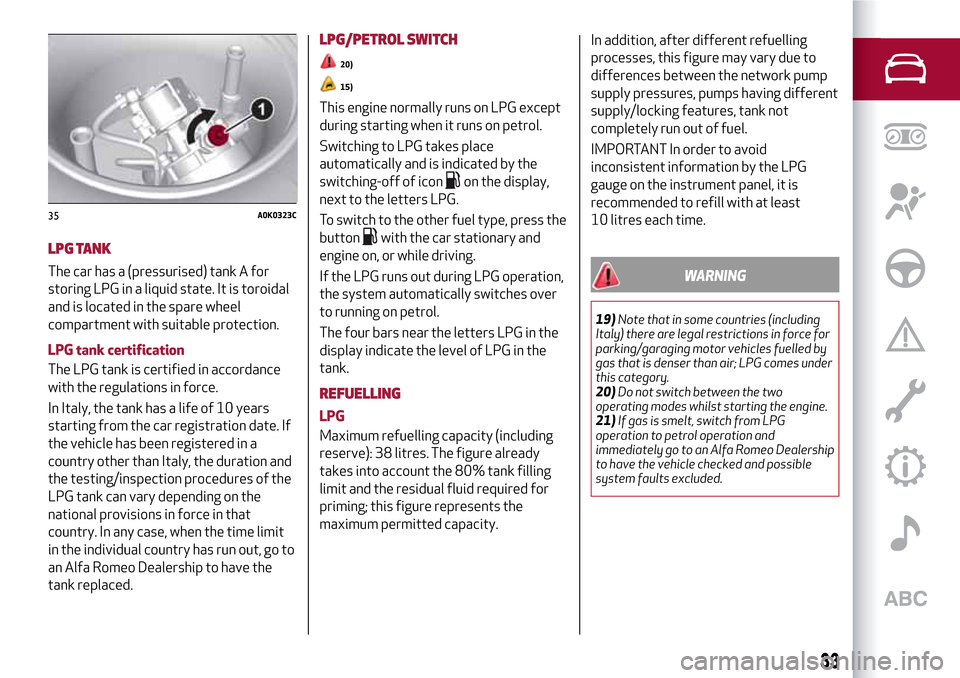
LPG TANK
The car has a (pressurised) tank A for
storing LPG in a liquid state. It is toroidal
and is located in the spare wheel
compartment with suitable protection.
LPG tank certification
The LPG tank is certified in accordance
with the regulations in force.
In Italy, the tank has a life of 10 years
starting from the car registration date. If
the vehicle has been registered in a
country other than Italy, the duration and
the testing/inspection procedures of the
LPG tank can vary depending on the
national provisions in force in that
country. In any case, when the time limit
in the individual country has run out, go to
an Alfa Romeo Dealership to have the
tank replaced.
LPG/PETROL SWITCH
20)
15)
This engine normally runs on LPG except
during starting when it runs on petrol.
Switching to LPG takes place
automatically and is indicated by the
switching-off of icon
on the display,
next to the letters LPG.
To switch to the other fuel type, press the
button
with the car stationary and
engine on, or while driving.
If the LPG runs out during LPG operation,
the system automatically switches over
to running on petrol.
The four bars near the letters LPG in the
display indicate the level of LPG in the
tank.
REFUELLING
LPG
Maximum refuelling capacity (including
reserve): 38 litres. The figure already
takes into account the 80% tank filling
limit and the residual fluid required for
priming; this figure represents the
maximum permitted capacity.In addition, after different refuelling
processes, this figure may vary due to
differences between the network pump
supply pressures, pumps having different
supply/locking features, tank not
completely run out of fuel.
IMPORTANT In order to avoid
inconsistent information by the LPG
gauge on the instrument panel, it is
recommended to refill with at least
10 litres each time.
WARNING
19)Note that in some countries (including
Italy) there are legal restrictions in force for
parking/garaging motor vehicles fuelled by
gas that is denser than air; LPG comes under
this category.
20)Do not switch between the two
operating modes whilst starting the engine.
21)If gas is smelt, switch from LPG
operation to petrol operation and
immediately go to an Alfa Romeo Dealership
to have the vehicle checked and possible
system faults excluded.
35A0K0323C
33
Page 90 of 212
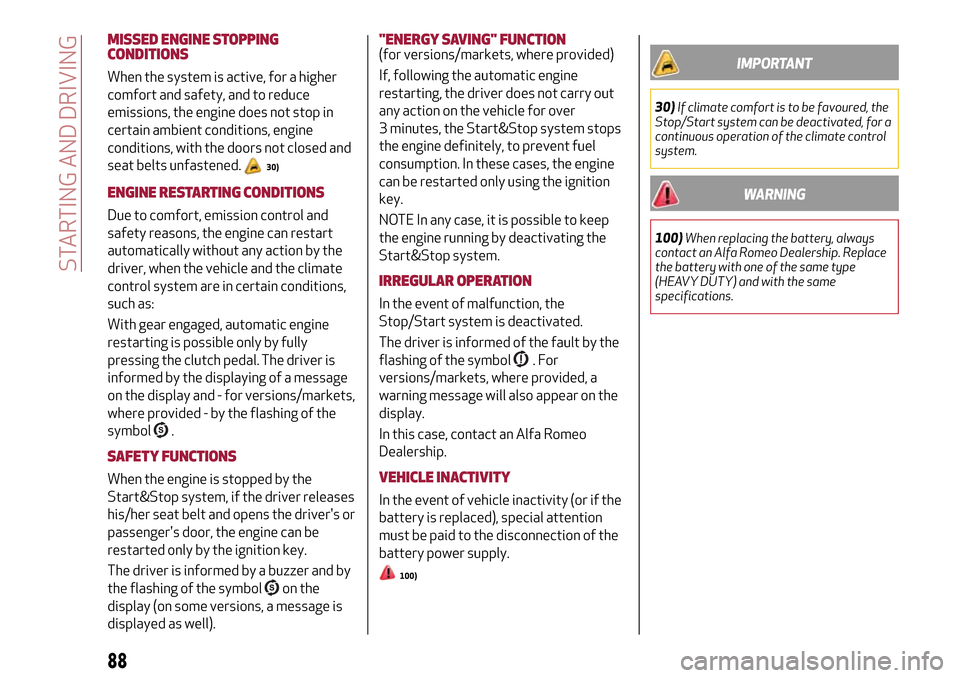
MISSED ENGINE STOPPING
CONDITIONS
When the system is active, for a higher
comfort and safety, and to reduce
emissions, the engine does not stop in
certain ambient conditions, engine
conditions, with the doors not closed and
seat belts unfastened.
30)
ENGINE RESTARTING CONDITIONS
Due to comfort, emission control and
safety reasons, the engine can restart
automatically without any action by the
driver, when the vehicle and the climate
control system are in certain conditions,
such as:
With gear engaged, automatic engine
restarting is possible only by fully
pressing the clutch pedal. The driver is
informed by the displaying of a message
on the display and - for versions/markets,
where provided - by the flashing of the
symbol
.
SAFETY FUNCTIONS
When the engine is stopped by the
Start&Stop system, if the driver releases
his/her seat belt and opens the driver's or
passenger's door, the engine can be
restarted only by the ignition key.
The driver is informed by a buzzer and by
the flashing of the symbol
on the
display (on some versions, a message is
displayed as well).
"ENERGY SAVING" FUNCTION(for versions/markets, where provided)
If, following the automatic engine
restarting, the driver does not carry out
any action on the vehicle for over
3 minutes, the Start&Stop system stops
the engine definitely, to prevent fuel
consumption. In these cases, the engine
can be restarted only using the ignition
key.
NOTE In any case, it is possible to keep
the engine running by deactivating the
Start&Stop system.
IRREGULAR OPERATION
In the event of malfunction, the
Stop/Start system is deactivated.
The driver is informed of the fault by the
flashing of the symbol
.For
versions/markets, where provided, a
warning message will also appear on the
display.
In this case, contact an Alfa Romeo
Dealership.
VEHICLE INACTIVITY
In the event of vehicle inactivity (or if the
battery is replaced), special attention
must be paid to the disconnection of the
battery power supply.
100)
IMPORTANT
30)If climate comfort is to be favoured, the
Stop/Start system can be deactivated, for a
continuous operation of the climate control
system.
WARNING
100)When replacing the battery, always
contact an Alfa Romeo Dealership. Replace
the battery with one of the same type
(HEAVY DUTY) and with the same
specifications.
88
STARTING AND DRIVING
Page 94 of 212
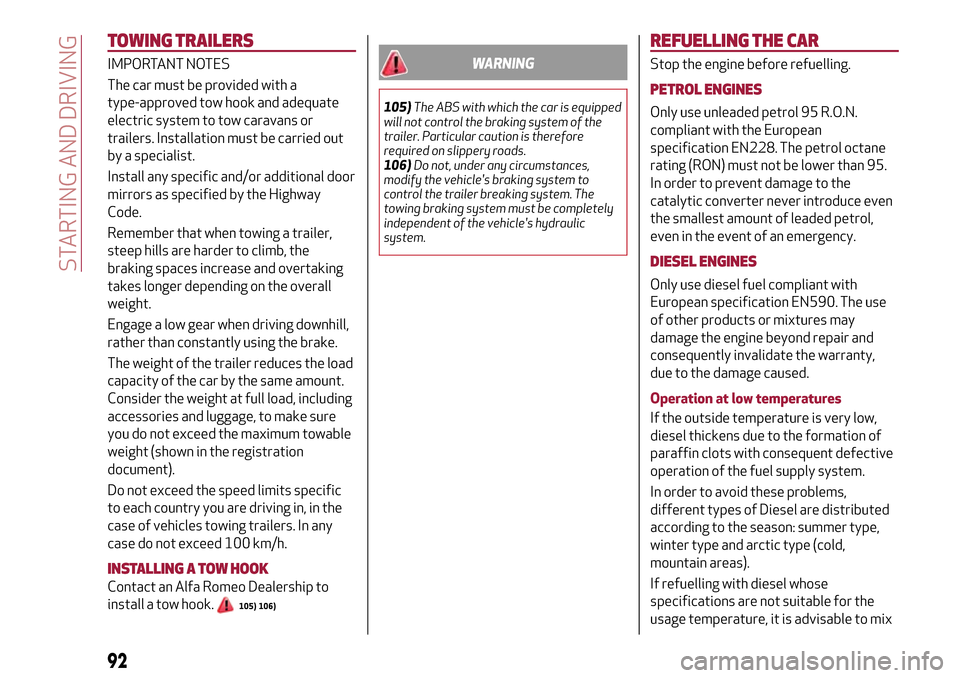
TOWING TRAILERS
IMPORTANT NOTES
The car must be provided with a
type-approved tow hook and adequate
electric system to tow caravans or
trailers. Installation must be carried out
by a specialist.
Install any specific and/or additional door
mirrors as specified by the Highway
Code.
Remember that when towing a trailer,
steep hills are harder to climb, the
braking spaces increase and overtaking
takes longer depending on the overall
weight.
Engage a low gear when driving downhill,
rather than constantly using the brake.
The weight of the trailer reduces the load
capacity of the car by the same amount.
Consider the weight at full load, including
accessories and luggage, to make sure
you do not exceed the maximum towable
weight (shown in the registration
document).
Do not exceed the speed limits specific
to each country you are driving in, in the
case of vehicles towing trailers. In any
case do not exceed 100 km/h.
INSTALLING A TOW HOOK
Contact an Alfa Romeo Dealership to
install a tow hook.
105) 106)
WARNING
105)The ABS with which the car is equipped
will not control the braking system of the
trailer. Particular caution is therefore
required on slippery roads.
106)Do not, under any circumstances,
modify the vehicle's braking system to
control the trailer breaking system. The
towing braking system must be completely
independent of the vehicle's hydraulic
system.
REFUELLING THE CAR
Stop the engine before refuelling.
PETROL ENGINES
Only use unleaded petrol 95 R.O.N.
compliant with the European
specification EN228. The petrol octane
rating (RON) must not be lower than 95.
In order to prevent damage to the
catalytic converter never introduce even
the smallest amount of leaded petrol,
even in the event of an emergency.
DIESEL ENGINES
Only use diesel fuel compliant with
European specification EN590. The use
of other products or mixtures may
damage the engine beyond repair and
consequently invalidate the warranty,
due to the damage caused.
Operation at low temperatures
If the outside temperature is very low,
diesel thickens due to the formation of
paraffin clots with consequent defective
operation of the fuel supply system.
In order to avoid these problems,
different types of Diesel are distributed
according to the season: summer type,
winter type and arctic type (cold,
mountain areas).
If refuelling with diesel whose
specifications are not suitable for the
usage temperature, it is advisable to mix
92
STARTING AND DRIVING
Page 95 of 212
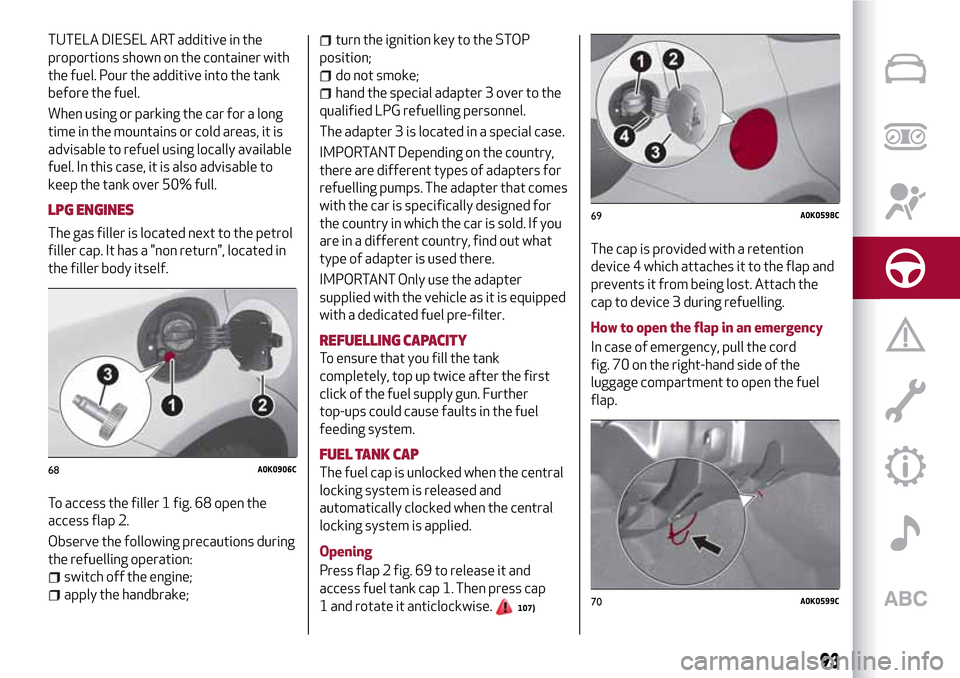
TUTELA DIESEL ART additive in the
proportions shown on the container with
the fuel. Pour the additive into the tank
before the fuel.
When using or parking the car for a long
time in the mountains or cold areas, it is
advisable to refuel using locally available
fuel. In this case, it is also advisable to
keep the tank over 50% full.
LPG ENGINES
The gas filler is located next to the petrol
filler cap. It has a "non return", located in
the filler body itself.
To access the filler 1 fig. 68 open the
access flap 2.
Observe the following precautions during
the refuelling operation:
switch off the engine;
apply the handbrake;
turn the ignition key to the STOP
position;
do not smoke;
hand the special adapter 3 over to the
qualified LPG refuelling personnel.
The adapter 3 is located in a special case.
IMPORTANT Depending on the country,
there are different types of adapters for
refuelling pumps. The adapter that comes
with the car is specifically designed for
the country in which the car is sold. If you
are in a different country, find out what
type of adapter is used there.
IMPORTANT Only use the adapter
supplied with the vehicle as it is equipped
with a dedicated fuel pre-filter.
REFUELLING CAPACITY
To ensure that you fill the tank
completely, top up twice after the first
click of the fuel supply gun. Further
top-ups could cause faults in the fuel
feeding system.
FUEL TANK CAP
The fuel cap is unlocked when the central
locking system is released and
automatically clocked when the central
locking system is applied.
Opening
Press flap 2 fig. 69 to release it and
access fuel tank cap 1. Then press cap
1 and rotate it anticlockwise.
107)
The cap is provided with a retention
device 4 which attaches it to the flap and
prevents it from being lost. Attach the
cap to device 3 during refuelling.
How to open the flap in an emergency
In case of emergency, pull the cord
fig. 70 on the right-hand side of the
luggage compartment to open the fuel
flap.
68A0K0906C
69A0K0598C
70A0K0599C
93
Page 96 of 212
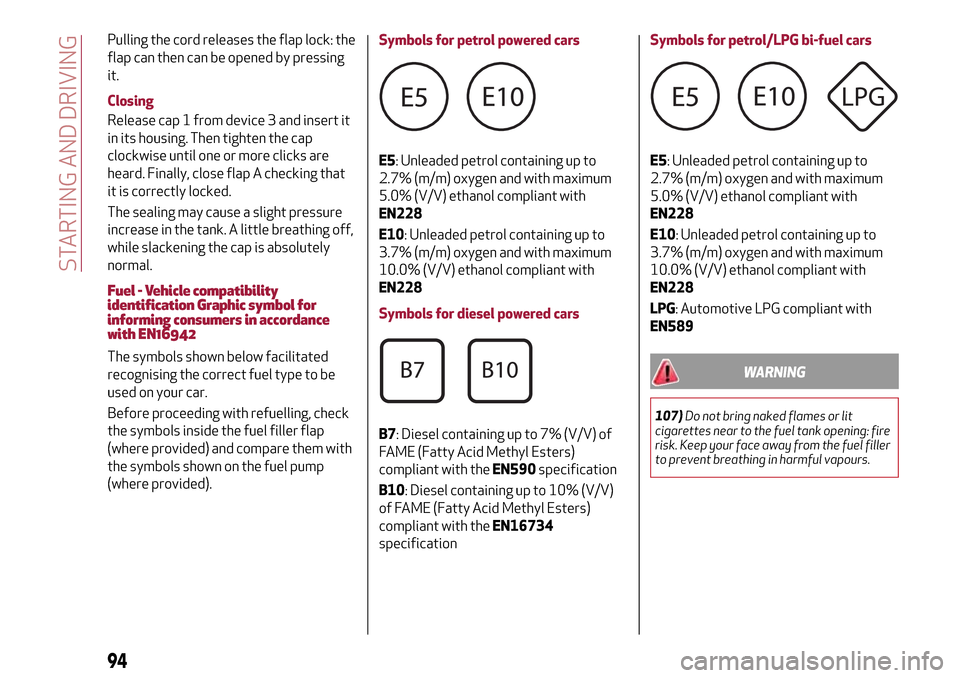
Pulling the cord releases the flap lock: the
flap can then can be opened by pressing
it.
Closing
Release cap 1 from device 3 and insert it
in its housing. Then tighten the cap
clockwise until one or more clicks are
heard. Finally, close flap A checking that
it is correctly locked.
The sealing may cause a slight pressure
increase in the tank. A little breathing off,
while slackening the cap is absolutely
normal.
Fuel - Vehicle compatibility
identification Graphic symbol for
informing consumers in accordance
with EN16942
The symbols shown below facilitated
recognising the correct fuel type to be
used on your car.
Before proceeding with refuelling, check
the symbols inside the fuel filler flap
(where provided) and compare them with
the symbols shown on the fuel pump
(where provided).Symbols for petrol powered cars
E5: Unleaded petrol containing up to
2.7% (m/m) oxygen and with maximum
5.0% (V/V) ethanol compliant with
EN228
E10: Unleaded petrol containing up to
3.7% (m/m) oxygen and with maximum
10.0% (V/V) ethanol compliant with
EN228
Symbols for diesel powered cars
B7: Diesel containing up to 7% (V/V) of
FAME (Fatty Acid Methyl Esters)
compliant with theEN590specification
B10: Diesel containing up to 10% (V/V)
of FAME (Fatty Acid Methyl Esters)
compliant with theEN16734
specificationSymbols for petrol/LPG bi-fuel cars
E5: Unleaded petrol containing up to
2.7% (m/m) oxygen and with maximum
5.0% (V/V) ethanol compliant with
EN228
E10: Unleaded petrol containing up to
3.7% (m/m) oxygen and with maximum
10.0% (V/V) ethanol compliant with
EN228
LPG: Automotive LPG compliant with
EN589WARNING
107)Do not bring naked flames or lit
cigarettes near to the fuel tank opening: fire
risk. Keep your face away from the fuel filler
to prevent breathing in harmful vapours.
94
STARTING AND DRIVING
Page 168 of 212
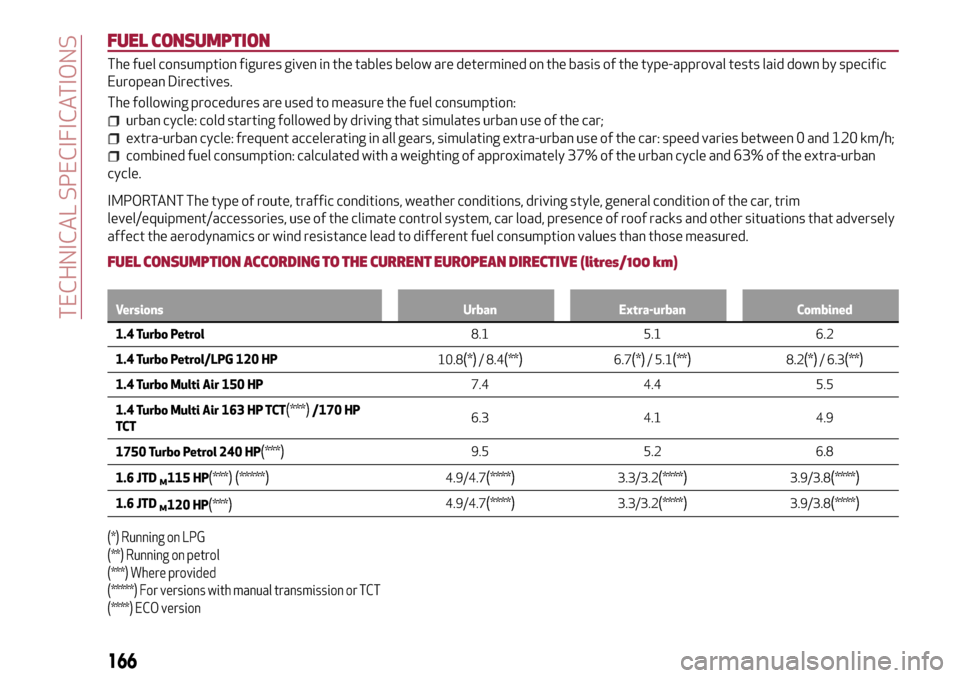
FUEL CONSUMPTION
The fuel consumption figures given in the tables below are determined on the basis of the type-approval tests laid down by specific
European Directives.
The following procedures are used to measure the fuel consumption:
urban cycle: cold starting followed by driving that simulates urban use of the car;
extra-urban cycle: frequent accelerating in all gears, simulating extra-urban use of the car: speed varies between 0 and 120 km/h;
combined fuel consumption: calculated with a weighting of approximately 37% of the urban cycle and 63% of the extra-urban
cycle.
IMPORTANT The type of route, traffic conditions, weather conditions, driving style, general condition of the car, trim
level/equipment/accessories, use of the climate control system, car load, presence of roof racks and other situations that adversely
affect the aerodynamics or wind resistance lead to different fuel consumption values than those measured.
FUEL CONSUMPTION ACCORDING TO THE CURRENT EUROPEAN DIRECTIVE (litres/100 km)
Versions Urban Extra-urban Combined
1.4 Turbo Petrol8.1 5.1 6.2
1.4 Turbo Petrol/LPG 120 HP
10.8
(*)/ 8.4(**)6.7(*)/ 5.1(**)8.2(*)/ 6.3(**)
1.4 Turbo Multi Air 150 HP7.4 4.4 5.5
1.4 Turbo Multi Air 163 HP TCT
(***)/170 HP
TCT6.3 4.1 4.9
1750 Turbo Petrol 240 HP
(***)9.5 5.2 6.8
1.6 JTD
M115 HP(***)(*****)4.9/4.7(****)3.3/3.2(****)3.9/3.8(****)
1.6 JTDM120 HP(***)4.9/4.7(****)3.3/3.2(****)3.9/3.8(****)
(*) Running on LPG
(**) Running on petrol
(***) Where provided
(*****) For versions with manual transmission or TCT
(****) ECO version
166
TECHNICAL SPECIFICATIONS
Page 208 of 212

Fitting "Universal" child restraint
system..................69
Fix&Go kit.................113
Flashing the headlights..........18
Fluids and lubricants...........162
Front airbag driver's side.........75
Front airbags................75
Front fog lights...............18
bulb replacement...........101
Fuel consumption............166
Fuel cut-off system...........117
Fuel tank cap................93
Fuses (replacement)...........102
Gear Shift Indicator............38
Handbrake.................83
Hazard warning lights...........96
HBA system.................60
Head restraints...............15
Front head restraints.........15
Rear head restraints..........15
Headlights..................31
Adjusting the headlights abroad . . .31
Headlight alignment corrector....18
Light beam direction..........31
Hill Holder system.............61
Identification data
chassis marking............145
engine marking............145identification data plate.......144
Ignition device................9
Steering lock...............9
Installing a Universal Isofix child
restraint system............72
Interior lights................20
Interiors (cleaning)............141
Isofix child restraint system setup . . .72
iTPMS System (indirect Tyre
Pressure Monitoring System)....62
Jack.....................110
Jump starting...............116
Keys
Key with remote control.........8
Lifting the vehicle............140
Light bulbs
types of bulbs..............97
LPG version.................32
Luggage compartment
Bag hooks................30
Closing the luggage compartment.......................30
Emergency luggage compartment
opening..................30
Extending the luggage
compartment..............30
Luggage compartment
initialisation...............30
Luggage retaining net.........30
Opening the boot............30
Main beam headlights..........18bulb replacement...........100
Manual climate control system.....22
Manual transmission...........86
Menu items.................40
MSR system . . ..............60
Multimedia
"APPS" Mode..........181 ,194
Anti-theft............184 ,197
CD....................179
Controls on the front panel
(Uconnect™ 5" Radio LIVE).....173
Controls on the front panel
(Uconnect™ 6.5" Radio Nav LIVE) .185
Navigation mode...........193
Phone mode...........180 ,191
Power on/off..........177 ,189
SD Card support...........191
Settings.............182 ,196
Uconnect™ LIVE Services . . .181 ,194
Voice commands........183 ,196
Number plate lights
bulb replacement...........102
Parking lights................17
Parking sensors ..............90
Parking the vehicle
Handbrake................83
Passenger side front airbag.......75
Performance . ..............165
Pollen filter................137
INDEX
"Follow Me Home" device.........19